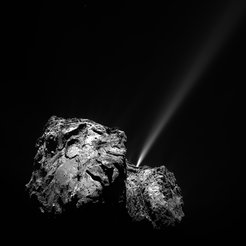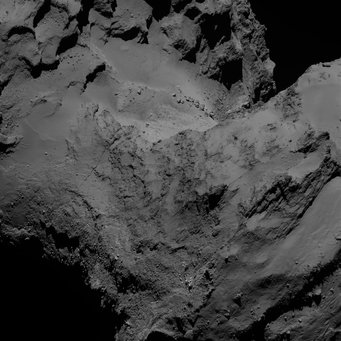A New Encounter with Rosetta’s Comet
On September 30, 2016, the Rosetta mission ended: ESA’s space probe performed a hard landing and subsequently crashed on comet 67P/Churyumov-Gerasimenko, which it had previously studied at close range for more than two years. Since then, Rosetta’s comet has been traveling without terrestrial escort on its roughly six-and-a-half-year orbit around the Sun. Earlier this month, 67P reached the point closest to the Sun the first time since the end of the Rosetta mission and is currently very close to Earth. Until the end of the month, the comet will be visible well into the early morning hours using amateur telescopes.
The Max Planck Institute for Solar System Research (MPS) contributed several scientific instruments to the Rosetta mission. For example, the institute provided the scientific camera system OSIRIS and operated it throughout the mission. In this interview, Dr. Holger Sierks, Principal Investigator of the OSIRIS team, and comet scientist and OSIRIS team member Dr. Carsten Güttler talk about a possible return to the Rosetta comet, comet simulations in the lab, and calibrating 70,000 images.
According to textbooks, one orbit of Rosetta’s comet 67P/Churyumov-Gerasimenko around the Sun takes about 6.6 years. With this regularity, it should thus also reach its closest point to the Sun. However, the comet reached its perihelion this year much earlier, after only 6.23 years. What's going on?

Güttler Admittedly, we too were also a little surprised. But there is a simple explanation. In recent years, 67P and Jupiter have come very close to each other on their orbits. This constellation occurs only rarely. Jupiter's gravitational forces have altered the comet's path a bit.
Sierks It is still unclear what this means for the comet itself. Such an encounter not only alters the trajectory of the smaller body. The comet itself is also exposed to strong forces. Comets are not solid, stable chunks, but have a very low density, they are very fragile. I am thinking, for example, of the large fracture that runs through 67P at the "neck". This could well have changed.
Güttler The encounter with Jupiter could also have affected the comet’s rotation period or the inclination of the rotation axis. The latter would, for example, alter the seasons on the comets, i.e. when which regions experience how much sunlight. And that, in turn, could influence which areas of the comet emit particularly large amounts of gas and dust into space and are thus gradually eroded.
Many observation campaigns are currently underway studying Rosetta’s comet with ground-based or space telescopes. At the same, time 67P is the best-studied comet of all. Are the current observations about these changes of the orbital parameters?
Sierks Certainly, but not only. Because actually we don't know that much yet. Before Rosetta, cometary missions were flybys; the measured data showed a brief snapshot. Rosetta, on the other hand, accompanied "its" comet for more than two years and was able to witness how it emitted increasingly more gas and dust on its way to perihelion and then quieted down again. Nevertheless, even these two years are only a tiny fraction in the life of a comet. Many questions about how comets evolve and change during their "lives" are still open. We also do not yet know the exact nature and composition of cometary material. For this reason, there are plans to return to 67P with a spacecraft and bring a sample of cometary material back to Earth.
You mean NASA's CAESAR mission. What is the current status?
Sierks Two years ago, the mission was unfortunately not included in NASA's New Frontiers program; the Dragonfly mission, which will land on Saturn's moon Titan, was chosen instead. CAESAR, however, made it to the final round and was found to be excellent. The entire team, including Carsten and I as Co-Investigators, is now continuing to work on improving and refining the mission concept. We very much hope that CAESAR will be confirmed in the next New Frontiers round (NF5).
Why should this mission head for the Rosetta comet, of all places?
Sierks We know the Rosetta comet, its exact shape and activity better than any other comet. This makes it much more likely that another landing will work and that the sampling can be successfully implemented. And scientifically, too, a so-called sample return mission would be a stroke of luck. After all, the observational data from the Rosetta mission allow the ground sample to be understood in a much larger context.
Missions to bring asteroid material to Earth have already been successful or are underway: Japan's Hayabusa probes took samples from the asteroids Itokawa and Ryugu. And NASA's OSIRIS-Rex probe is currently on its way back to Earth with its sample from asteroid Bennu. Why is such a mission to a comet still pending?
Güttler There are several reasons for this. Unlike asteroids, the orbits of comets are very eccentric. In the case of 67P, this means that the point farthest from the Sun in its orbit is 4.5 times as far away from the Sun as the point closest to the Sun. Moreover, when 67P is quite close to the Sun - and thus to Earth - it moves very fast. As a result, comets generally require much more effort to reach than asteroids. For the Rosetta mission, for example, the journey took ten years. Of course, this causes immense costs. Secondly, the sample itself plays a role. Asteroids are usually dry, whereas comets are a mixture of different, deep-frozen ices - water and CO2, for example - and dust. In this case, you have to think carefully about how to bring this mixture to Earth as unaltered as possible. At the latest on re-entry into the atmosphere, the frozen gases would melt or sublimate if they were not cooled at great expense.
How does CAESAR solve this problem?
Güttler The CAESAR mission intends to separate the gases and the dusty components from each other already during the flight. Once they arrive on Earth, the two are then analyzed separately.
Sierks As with OSIRIS-Rex, the sample is to be collected by a touch-and-go maneuver, that is, with only very brief contact with the surface. This takes only a few seconds. It is important to proceed as gently as possible so that the morphology, i.e. the exact nature of the dust particles, is preserved. This allows us to draw conclusions about the formation and development of comets. Cometary dust is likely extremely fluffy. These fragile structures must be preserved as much as possible during sampling and transport to Earth.
What is cometary dust like? What do we know?
Güttler We assume that individual microscopic dust particles initially form loose agglomerates that are only a few millimeters or centimeters in size. This happens through surface forces, so they literally stick together. In a later step, these agglomerates come together, ultimately by gravitation, to form a comet. However, that was already 4.6 billion years ago and we do not understand much in detail yet. For example, the activity of the comet as it approaches the Sun. It is still unclear how the sublimating gas from the comet's near-surface layers pulls the dust clusters into space with it. According to our current understanding of the forces at work, this shouldn't be possible at all. Nevertheless, we can clearly see these dust fountains in camera images of Rosetta. Some of them reach many kilometers into space. To better understand these processes, we are currently conducting laboratory experiments at MPS as part of the CoPhyLab research network.
What kind of experiments?
Güttler First of all, we are concerned with the very basics. We want to understand how the gas escaping from the comet makes its way through the top layer of dust. What forces are at work, what pressure is generated? To do this, we have recreated this layer – to start with in a highly idealized form. In our experiment, we simulate the comet dust with tiny steel spheres. A gas is pumped through them, and we measure what pressure is required. This may sound quite simple. But we are trying to understand this process in detail down to the individual gas molecule with additional computer simulations. Ultimately, we want to learn how these gas molecules lift and entrain the dust clusters - or steel spheres. This is close to the activity of a comet. All this helps us to better understand and classify the observational data from the Rosetta mission.
Are the data from Rosetta still being analyzed?

Sierks Absolutely. OSIRIS alone has taken nearly 70,000 images of the comet. Even five years after the end of the mission, a great deal has been evaluated, but by no means everything. For example, many images show fountains of gas escaping from the comet into space. Since these images were taken through different filters of the camera, it is possible to draw conclusions about the composition of the gases. We have not yet investigated this in more detail. The Rosetta instrument ROSINA has analyzed the composition of the gas through in situ measurements. However, such data are, by their nature, always limited to a particular place in space and time. The OSIRIS data could put the ROSINA measurements in a larger context, covering the entire comet.
Güttler The data from the Rosetta mission are unique and will continue to be invaluable in the years and decades to come. Even when future cometary missions collect new observational data, the Rosetta data will be the reference. After all, our goal is not just to study individual comets as well as possible, but to better understand this class of celestial bodies as a whole. Therefore, it will always be important to correlate data from different missions and observational campaigns. We have therefore worked over the past two years to process the complete OSIRIS data and make it accessible and usable for all researchers in an even better form. This work has now been completed.
What did you have to do?
Güttler In order for the OSIRIS images to be as meaningful as possible, they have to be calibrated as well as possible. On the one hand, this concerns the brightness of the individual pixels. We want to make sure that the brightness of each pixel represents an exact amount of light reflected from a spot on the comet. This is the only way to interpret the images correctly later. That is why we have calibrated OSIRIS with high precision. To do this, we use OSIRIS images of stars whose brightness is known very precisely. With these, you can find out exactly how the OSIRIS camera reacts to a certain amount of light and how this is then reflected in the images.
Are there other challenges to these calibrations?
Güttler Of course. Interpreting the exact geometry in the images is very challenging. After all, for every single pixel in the image, we want to know exactly where it is in space. This is complicated by the complex shape of the comet. In addition, the spacecraft is moving; the comet is rotating. This is very difficult to calculate. Also, it is important to know the angle at which the sunlight is incident. Only then can the bright and dark areas be interpreted correctly. Are they shadows? Or structures? We have now calculated this information for each image and make it available together with the image data. All scientists can now easily use the OSIRIS data for further studies. Calibrated in this way, the OSIRIS data now form the central part of the Rosetta mission's legacy.













